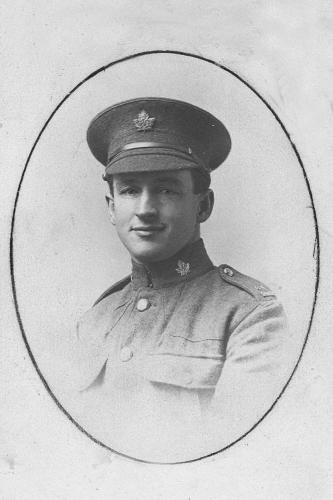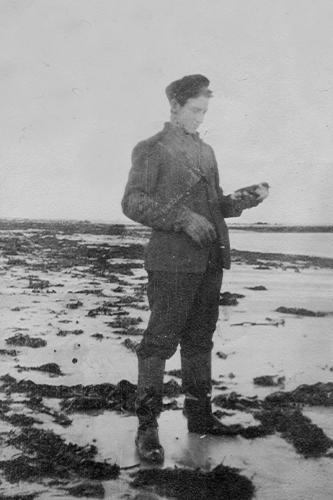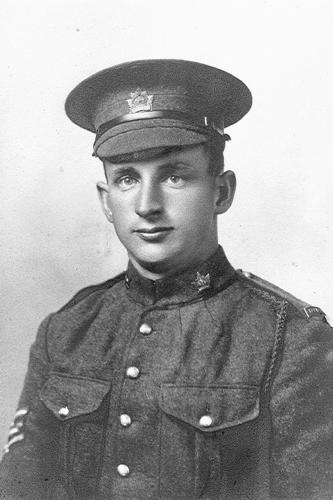
copyright © Wartime Heritage Association
Website hosting courtesy of Register.com - a web.com company
Wartime Heritage
ASSOCIATION
Sergeant Herbert Lorraine Cunningham
Herbert
Lorraine
Cunningham
was
born
on
April
24,
1891.
His
mother
Leona
May,
and
father
John
lived
on
the
Hawk,
Cape
Sable
Island.
Herb
had
three older sisters, Geneva, Mary and Imogine.
In
a
predominately
small
community
such
as
the
Hawk,
fishing
was
the
average man’s profession. His father was a ship’s engineer.
When
Herb
was
seven
years
old
his
father
died.
During
those
days
when
a
parent
died
in
a
family
occasionally
the
family
was
broken
up
and
some
of
the
children
went
to
live
with
relatives.
Herb
and
his
sister
Mary
went to live with his Aunt Gustie, and uncle Marshall at the Hawk.
Herb
had
picked
up
his
fathers
profession
and
worked
at
the
Cape
Sable
lighthouse
for
three
years
as
the
assistant
for
his
uncle
Arthur
Cunningham.
He
was
an
adventurous
boy
who
loved
to
fish.
His
daughter,
Betty,
told
a
story
her
father
had
told
her
about
a
time
when
he
was
a
teenager.
“Herb,
as
a
young
boy
was
going
home
with
some
of
his
friends
for
the
night.
One
of
Herb’s
friends,
Arnold
Lowe,
was
scared
of
the
dark.
Herb
told
his
friend
Arnold
that
he
would
walk
him
home
that
night
only
if
Arnold piggybacked him the whole way.”
On
April
12,
1915,
at
the
age
of
24,
Herb
enlisted
in
Yarmouth,
N.S.
with
the
40th
Battalion.
Since
Herb
was
well
educated
and
an
engineer
he
was
given
the
rank
of
Sergeant
in
the
40th
Battalion.
He
went
overseas
to
England
with
the
40th
Battalion;
however,
with
a
desire
to
join
the
battle
in
France,
on
March
15,
1916
he
took
a
reduction
in
rank
to
Private
and
joined
the
60th
Battalion.
A
few
days
after
he
had
joined
the
60th
Battalion
he
was shipped to France.
In
May
of
1915,
the
60th
Canadian
Infantry
Battalion
was
first
organized
under
command
of
Lieutenant
Colonel
F.
A.
Gascoigne,
and
was
mobilized
in
Montreal,
Canada.
On
November
6,
1915
the
Battalion
left
from
Montreal
and
boarded
the
ship
“Scandinavian”.
The
ship
arrived
in
England
and
unloaded
on
November
16
of
that
same
year.
The
Battalion
was
comprised
of
40
officers
and
had
1024
men
classified
into
other
ranks.
On
February
20,
1916
the
Battalion
arrived
in
France
where
they
met
up
with
the
23rd
Canadian
Reserve
Battalion.
However,
in
April
the
23rd
Battalion
was
withdrawn,
and
the
60th
Battalion
was
joined
with
the
116th
Battalion.
The
60th
(the
Victoria
Rifles
of
Canada)
was
part
of
the
Third
Canadian
Division.
On
July
15,
1916,
Herb
was
promoted
to
Lance
Corporal,
and
then
on
October 8 was promoted to Corporal. In April, 1917 he was at Vimy Ridge.
Herb
was
wounded
on
April
13,
1917.
He
was
hit
by
enemy
shrapnel
on
the
outside
in
the
middle
of
his
left
thigh.
The
cut
was
approximately
3”
by
4”.
It
wasn’t
until
April
3rd
that
he
was
admitted
to
the
Canadian
General
Hospital
in
Boulogne.
He
was
then
transferred
moved
to
the
East
Leeds War Hospital, Harehills, Yorkshire, England.
His
medical
records
stated
that
he
had
been
hit
by
a
shell
shrapnel,
and
it
had
wounded
him
on
the
thigh
of
his
left
leg.
When
the
wound
healed
it
left
a
scar
3”by
4”,
it
was
slightly
tender,
and
was
partly
attached
to
the
muscle
below
it,
resulting
in
small
loss
of
muscle
tissue.
His
left
leg
was
one
inch
smaller
that
his
right
leg.
Hospital
officials
concluded
that
after
walking
one
mile
Herb
left
leg
would
grow
tired
and
sore,
and
in
wet
and
cold
weather
his
symptoms
would
worsen.
He
walked
with
a
slight
limp
and
sometimes
his
toes
of
the
left
foot
would
drop
and
drag.
He
suffered
hearing
loss
in
his
left
ear
which
had
been
brought
on
from
a
concussion.
Descendants
of
Herb
remember
his
left
leg
being
abnormally
small
compared to his right leg due to loss of muscle.
During
the
month
of
November
1917,
Herb
experienced
deafness
and
discharge
of
fluid
from
his
left
ear.
In
his
right
ear
he
could
hear
a
whisper
from
a
distance
of
4
feet
away,
and
he
could
hear
a
voice
from
a
distance
of
20
feet
away.
In
his
left
ear
he
could
not
hear
a
thing.
He
was
told
to
continually
wipe
his
ears
and
to
use
a
solution
of
alcohol
and
borasic
drops
three times a day until otherwise stated.
Grace
Elizabeth
Ayres
from
Newbury,
Berkshire,
England
was
a
volunteer
at
the
hospital.
Herb
was
there
for
six
months
and
during
his
stay
he
became
acquainted
with
Elizabeth.
A
romance
followed
and
on
October
24, 1918, Herb was granted permission to marry Grace.
Now
27
years
old
and
considered
medically
unfit,
Herb
arrived
back
in
Halifax
on
December
31,
1918
and
was
discharged
on
February
18,
1919.
Upon his discharge he was given a post discharge pay of $515.00.
Herb
returned
to
Yarmouth
with
his
wife
and
in
1922
took
a
position
as
a
Light
Keeper,
at
the
Cape
Forchu
Light
station.
Through
the
years
Grace and Herb had six children.
Betty
could
recall
of
some
of
the
things
her
father
could
never
eat,
one
being
orange
marmalade
because
it
reminded
him
of
one
of
his
fellows
being
killed;
another
margarine,
because
it
was
fed
to
them
so
much
during
the
war.
He
didn’t
like
the
fact
that
it
was
artificially
coloured
and
he
couldn’t
stand
eating
something
he
didn’t
like
to
look
at.
He
also
did
not
like corned beef for it was rationed to him so much during the war.
In
1908
the
Canadian
government
in
partnership
with
a
company
in
Boston
installed
one
of
three
experimental
navigation
systems
at
Cape
Forchu.
The
system
consisted
of
two
submarine
bells
mounted
on
metal
tripods
at
the
bottom
of
the
sea
some
distance
off
the
end
of
Cape
Forchu.
Cables
ran
from
the
bells
to
a
building
attached
to
the
fog
alarm
building
at
the
Cape.
Electrical
signals
caused
these
bells
to
ring
in
a
preset
pattern.
Ships
with
microphones
mounted
to
the
inside
of
their
hulls
on
both
sides
could
listen
to
these
bells
from
some
distance
and
determine
the
bearing
to
the
site.
The
system
was
out
of
service
by
1914
due
to
difficulties
keeping
the
system
operational.
The
idea
of
underwater
sound
propagation
however
led
to
the
development
of
sonar
and
the
Boston
Company
became
the
modern day huge organization, Raytheon.
In
1927
Herb
noted
in
his
journal
that
a
cable
ship
had
arrived
to
remove the “submarine” cables running off the Cape.
In
November
1939
light
keepers
along
the
east
coast
of
the
Maritimes
became
part
of
the
coastal
defence
system.
The
Department
of
Transport
provided
a
set
of
instructions
and
code
words
to
each
lighthouse.
A
radio
message
was
sent
out
every
four
instructed
each
light
keeper
about
how
he
should
operate
their
lights
and
fog
horns
during
the
subsequent
period.
A
for
Apples
meant
that
all
was
okay
and
normal
operation
of
lights
and
fog
alarms
could
continue.
If
a
submarine
was
reported
to
be
working
in
a
particular
area
B
for
Butter
meant
extinguish
your
lights
and
fog
alarm,
there
are
unfriendly
visitors
are
in
your
area.
C
for
Charlie
was
the
signal
that
B
was
cancelled and normal operation could be resumed.
In
May
1940,
the
Royal
Canadian
Air
Force
(RCAF)
established
the
Aircraft
Detection
Corps
(ADC)
to
provide
additional
protection
along
Canada’s
coast
line
until
the
time
when
enough
operational
radar
sites
had
been
constructed.
Official
observation
posts
were
usually
positioned
in
a
location with a good communication connection like lighthouses.
Like
most
light
keepers
Herb
was
the
chief
observer
for
the
Cape
Forchu
observation
post
area.
He
preformed
this
role
with
the
same
dedication to duty as he showed during the First World War.
Herb
continued
living
at
Cape
Forchu
until
his
death
on
February
26,
1982.
Sources:
Library and Archives Canada (Attestation Paper)
School Project by Kerry Lynn Sweeney
Mike Cunningham (Grandson of Herbert Cunningham)

Herbert Cunningham - WWI

Pre-World War I
Herbert Cunningham - Beach at Cape Sable Island after Storm

Sergeant Herbert Cunningham - WWI

Herbert Cunningham - Leaving Yarmouth WWI (1915)
Sergeant Herbert Lorraine Cunningham
Force:
Army
Regiment:
Canadian Infantry
Battalion:
40th Battalion
Regimental Number:
415681
Date of Birth:
April 24, 1891
Place of Birth:
Clark’s Harbour, Nova Scotia
Place of Enlistment:
Yarmouth, Nova Scotia
Date of Enlistment:
April 12, 1915
Age at Enlistment:
24
Height: 5 Feet 10 Inches
Trade:
Engineer
Marital Status:
Single
Religion:
Wesleyan
Next of Kin:
(Mother) Mrs Isaac Mitchell,
Yarmouth, Nova Scotia
Saw service in:
Europe
Listed on the Nominal Roll of the 40th Battalion


- World War I - Menu
- WWI Stories and Articles
- Photos - Yarmouth Soldiers
- Selection of World War I Songs
- WWI Casualties of Yarmouth, NS
- Those Who Served - Yarmouth, NS
- WWI Casualties Digby Co. NS
- WWI Casualties Shelburne Co. NS
- Merchant Mariners (1915) Yarmouth, NS
- Canadian Forestry Corps - Non Yarmouth Birth/Residence Enlistments
- US Draft Registry - Yarmouth NS Born


- World War II - Menu
- WWII Stories and Articles
- Telegraphist Air Gunners
- WWII Casualties of Nova Scotia
- US Casualties with NS Connection
- Far East/Pacific Casualties with NS Connection
- Merchant Navy Casualties Nova Scotia
- Nova Scotia WWII Casualties Holten Canadian War Cemetery
- D-Day Casualties - Nova Scotia
- CANLOAN Program Casualties - Nova Scotia
- Battle of the Bulge Casualties - Nova Scotia
- WWII Casualties Yarmouth NS
- Yarmouth Casualties - RCAF RAF Canadian Army WWII
- Yarmouth Co., Marriages WWII
- Casualties Non-Born/Residents with Connection to Yarmouth Co., Nova Scotia.
- WWII Casualties Digby Co., NS
- Non-Nova Scotian WWII Casualties Buried in Nova Scotia
- WWII RCAF Casualties Aged 16-18
- Brothers/Sisters Who Served - World War II














